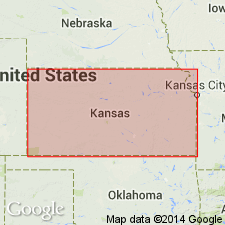
- Usage in publication:
-
- Big Blue series
- Modifications:
-
- Original reference
- Dominant lithology:
-
- Shale
- Limestone
- Salt
- Gypsum
- AAPG geologic province:
-
- Nemaha anticline
- Forest City basin
- Sedgwick basin
Summary:
Pg. 3, 5. Big Blue series. Limestone-bearing series, 900 to 1,100 feet thick, known by its fossils to belong to Permian. Underlies, probably unconformably, Cimarron series. Divided into Sumner division above and Flint Hills division below. Includes (descending) Wellington shales, Geuda salt measures, Chase limestones, and Neosho shales. Age is Permian.
[Named from Big Blue River, Marshall and Pottawatomie Cos., which in northern Kansas, cuts deeply into these rocks.]
[When referring to the Big Blue series of Cragin (1896), please use informally. The practice of employing "Series" for lithostratigraphic or lithodemic nomenclature is now regarded as improper (see ACSN, 1961, 1970; NACSN, 1983, 2005, 2021). The term "Series" is applied formally only to chronostratigraphic units.]
Source: US geologic names lexicon (USGS Bull. 896, p. 180-181); GNC KS-NE Permian Corr. Chart, Oct. 1936.

- Usage in publication:
-
- Big Blue series
- Big Blue group
- Modifications:
-
- Overview
Summary:
This name was not adopted by Kansas Geol. Survey until 1917 (R.C. Moore and W.P. Haynes, Kansas Geol. Survey Bull., no. 3), when it was called Big Blue group and defined as extending from top of Wellington shale to base of Cottonwood limestone. This definition of Big Blue group was also followed by Moore in his 1920 classification (Kansas Geol. Survey Bull., no. 6). R.C. Moore and G.E. Condra in their Oct. 1932 revised classification of Permian and Pennsylvanian rocks of Kansas still further expanded Big Blue series, as they called it, by including all beds down to base of Americus limestone. G.E. Condra in 1935 (Nebraska Geol. Survey Paper no. 8) and R.C. Moore in 1936 (Kansas Geol. Survey Bull., no. 22) still further expanded their Big Blue series by including in it all beds down to unconformity at top of Brownville limestone. The USGS has never adopted this name, and has not yet given consideration to change in Permian-Pennsylvanian boundary.
Source: US geologic names lexicon (USGS Bull. 896, p. 180-181).
For more information, please contact Nancy Stamm, Geologic Names Committee Secretary.
Asterisk (*) indicates published by U.S. Geological Survey authors.
"No current usage" (†) implies that a name has been abandoned or has fallen into disuse. Former usage and, if known, replacement name given in parentheses ( ).
Slash (/) indicates name conflicts with nomenclatural guidelines (CSN, 1933; ACSN, 1961, 1970; NACSN, 1983, 2005, 2021). May be explained within brackets ([ ]).

